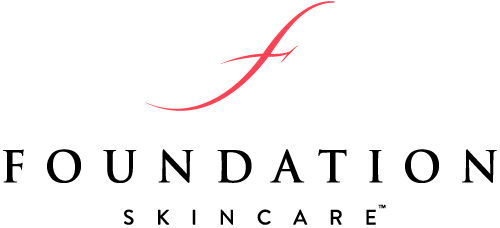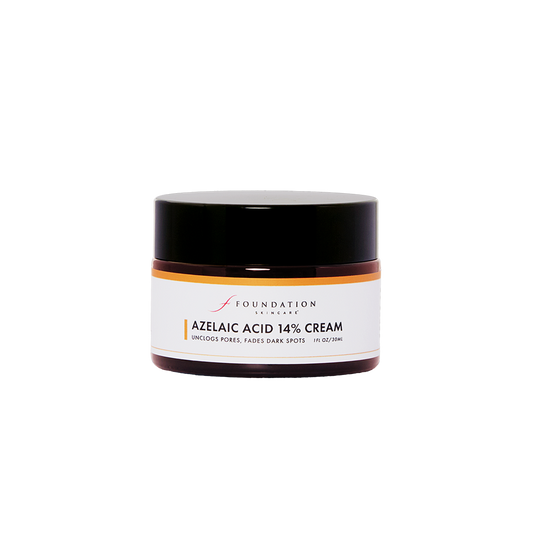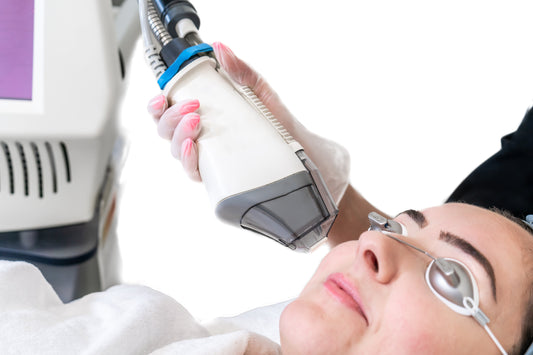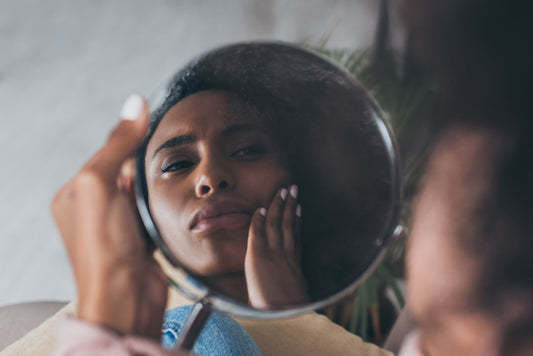Rosacea is a chronic skin condition that affects more than 14 million people in the U.S. Characterized by redness, flushing, visible blood vessels, and sometimes even acne-like breakouts, the condition is not curable, but it is possible to manage symptoms and avoid rosacea triggers to improve quality of life for those affected.1
Keep reading to find out what causes rosacea, how to avoid common triggers, and learn the best rosacea treatments available today.
Unraveling Causes & Contributing Factors of Rosacea
The cause of rosacea is not entirely known, though genetics, an overactive immune system, and certain lifestyle habits may play a part. There are also a number of known risk factors.2, 3 These include:
- Susceptibility to sunburns
- 30-50 age range
- History of smoking
- Family history of rosacea
- Celtic or Scandinavian ancestry
- Acne-prone skin
According to the American Academy of Dermatology, there are also a number of contributing factors that may play a role, though more research is needed.4 For instance, people with rosacea are more likely to carry a bug in their intestines called H pylori. It’s possible that an infection related to this bug can be a factor in susceptibility to rosacea. And many people with rosacea that appears like acne are known to react to a bacterium called bacillus oleronius, which can potentially cause the immune system to overreact.
Navigating Rosacea Triggers & How to Avoid Common Culprits
Beyond potential causes and risk factors, there appear to be many rosacea triggers. Tracking your symptoms may help you determine what’s causing your flare-ups, so you deal with them more efficiently.
Spicy Foods
Spicy foods are notorious for triggering flare-ups in many individuals. Capsaicin, the compound responsible for the heat in chili peppers, can dilate blood vessels and increase blood flow to the skin, leading to redness and flushing.5 Avoiding spicy foods or moderating your consumption may help reduce the frequency and severity of rosacea symptoms.
Alcohol
Alcohol, particularly red wine, is a well-known trigger for rosacea flare-ups. Red wine contains histamine and other inflammatory components (e.g. resveratrol) which may contribute to flushing and redness among rosacea patients.6 Limiting alcohol intake or avoiding it altogether can help manage symptoms of rosacea and prevent exacerbations.
Hot Beverages
Hot beverages like coffee and tea can also trigger symptoms in some individuals. The heat from these drinks can cause blood vessels to dilate, leading to flushing and redness.7 Opting for cooler or lukewarm beverages and avoiding excessive consumption can help minimize these effects.
Extreme Temperatures
Extreme temperatures, whether hot or cold, can also aggravate rosacea symptoms. Exposure to hot weather, saunas, hot baths, or heated indoor environments can trigger flushing and redness in susceptible individuals due to increased nerve activity.8
Similarly, cold weather and wind can cause skin irritation and lead to a flare-up.9 Protecting the skin from extreme temperatures with appropriate clothing and avoiding prolonged exposure may help.
Sun Exposure
You already know that heat from sun exposure can aggravate rosacea symptoms. But UV light from the sun is also known to damage keratinocytes in the skin, leading to the release of certain peptides that trigger inflammation, especially if you get a sunburn. It’s recommended to use broad-spectrum sunscreen daily with an SPF of 30+ (50+ preferred), wear protective clothing, and seek shade during peak sun hours.10
Azelaic Acid 14% Cream
• Brightens skin, fades brown spots
• Unclogs pores, improves texture
Sale price
$45
Stress
Many individuals report rosacea flare-ups during periods of increased stress and anxiety.11 While the exact mechanisms are not fully understood, stress is believed to trigger inflammatory responses in the body, exacerbating symptoms. Practicing stress-reduction techniques such as mindfulness meditation and deep breathing exercises can help manage stress levels and potentially minimize flare-ups.
Certain Skincare Products
Some skincare products, particularly those containing harsh ingredients or fragrances, should also be avoided. The National Rosacea Society conducted multiple surveys to determine the most triggering skincare products, which included: alcohol-based products, exfoliants, and astringents.12 These types of products, as well as those containing fragrances, may strip the skin of its natural oils and disrupt its barrier function, leading to irritation and redness. Opting for gentle, fragrance-free skincare products approved for sensitive skin can help soothe and protect rosacea-prone skin.
The Impact of Diet on Rosacea: How to Make Informed Food Choices
While diet alone cannot cure rosacea, certain foods and beverages have been reported to trigger flare-ups in some individuals. We already mentioned spicy foods, alcohol, and hot beverages above. Here are some other foods you should consider avoiding or limiting in your diet.
Foods to avoid:13
- Histamine-rich foods, like aged cheeses, wine, and processed meats
- Cinnamaldehyde-containing foods, like tomatoes, citrus fruits, and chocolate
- Fatty foods, including lard and fried foods
Keeping a food diary and identifying potential triggers can help individuals with rosacea make informed dietary choices and minimize flare-ups.
There are also a number of foods that have been shown to potentially ease or prevent symptoms.14
Foods to consider adding to your diet:
- Healthy fats and omega-3s, such as eggs, nuts, salmon, sardines, and olive oil
- Probiotics, like sauerkraut, kombucha, and kimchi
- Prebiotic-rich foods, including bananas, whole grains, asparagus, and garlic
Choosing Skincare Products Wisely
In addition to avoiding harsh products like those containing alcohol, consider adding gentle skincare products to your regimen that are proven to help reduce rosacea symptoms and minimize flare-ups.
One such product is azelaic acid, which has potent antimicrobial, anti-inflammatory, and antioxidant properties. A natural byproduct of yeast, azelaic acid works similarly to benzoyl peroxide and salicylic acid by unclogging pores and exfoliating skin, but it is far less abrasive, making it an ideal choice for those with sensitive skin or skin conditions like rosacea.
In one comprehensive 2023 review of 20 rosacea studies, azelaic acid was found to be significantly more effective compared to vehicle (a carrier substance not containing the active ingredient) in reducing inflammatory lesions in subjects with rosacea and decreasing redness severity.15 Azelaic acid was also strongly associated with overall improvement and treatment success. Most studies used 15% azelaic acid, which is only available by prescription.
Foundation Skincare’s Azelaic Acid 14% Cream contains the highest amount of azelaic acid available without a prescription. Most over-the-counter formulas have a lower concentration of the active ingredient, making them less effective, and many prescription-based azelaic acid products can be too harsh and irritate or dry out the skin, especially when formulated as a gel. We’ve found a 14% concentration in a hydrating cream base to be the sweet spot in helping to ease rosacea without irritating the skin. In fact FS Azelaic Acid 14% Cream is so gentle, it can be used morning and night. However, if your skin is sensitive or you notice any irritation when adding the product to your skincare routine, we recommend building up to using the product over the course of 2-3 weeks until your skin acclimates.
FS Azelaic Acid 14% Cream layers well with other products in the Foundation Skincare collection. Some other products you may want to consider include FS Niacinamide Lotion 10%, which calms inflamed skin and contributes to DNA repair, and FS Hyaluronic Acid Lotion, which deeply hydrates skin. Just be sure to use azelaic acid last in your skincare routine (following the thinnest-to-thickest application method), but before sunscreen.
Find out more about how azelaic acid works.
Beyond Skin Deep: Managing Rosacea Holistically
Managing rosacea goes beyond skincare and diet—it also involves addressing lifestyle factors and overall well-being, as most of our tips have suggested. Stress management techniques, regular exercise, adequate sleep, and maintaining a healthy weight can all contribute to managing rosacea symptoms and improving quality of life. Dealing with skincare conditions like rosacea can also take a toll on your mental health. If you are struggling with depression or anxiety related to the condition, consider speaking to a therapist or counselor for guidance and support.
Find more tips and resources on maintaining healthy skin and hair in the FS Journal.
References:
-
https://my.clevelandclinic.org/health/diseases/12174-rosacea
-
https://www.mayoclinic.org/diseases-conditions/rosacea/symptoms-causes/syc-20353815
-
https://www.aad.org/public/diseases/rosacea/what-is/causes
-
https://www.aad.org/public/diseases/rosacea/what-is/causes
-
https://pubmed.ncbi.nlm.nih.gov/35948328/
-
https://www.ncbi.nlm.nih.gov/pmc/articles/PMC5438297/
-
https://www.ncbi.nlm.nih.gov/pmc/articles/PMC9380265/
-
https://www.rosacea.org/tags/heat
-
https://www.rosacea.org/rosacea-review/2001/winter/tis-the-season-for-winter-flare-ups
-
https://www.sciencedirect.com/science/article/pii/S0022202X19333007
-
https://www.rosacea.org/tags/stress
-
https://www.rosacea.org/patients/skin-care-and-cosmetics
-
https://www.ncbi.nlm.nih.gov/pmc/articles/PMC8794493/
-
https://www.medicinenet.com/what_foods_are_good_for_rosacea/article.ht
-
https://onlinelibrary.wiley.com/doi/full/10.1111/jocd.15923





